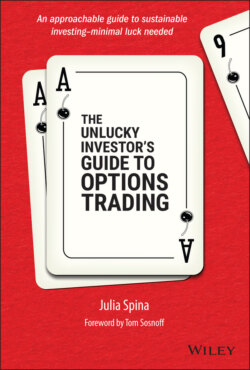Читать книгу The Unlucky Investor's Guide to Options Trading - Julia Spina - Страница 15
Оглавление
Introduction: Why Trade Options?
The house always wins. This cautionary quote is certainly true, but it does not tell the entire story. From table limits to payout odds, every game in a casino is designed to give the house a statistical edge. The casino may take large, infrequent losses at the slot machines or small, frequent losses at the blackjack table, but as long as patrons play long enough, the house will inevitably turn a profit. Casinos have long relied on this principle as the foundation of their business model: People can either bet against the house and hope that luck lands in their favor or be the house and have probability on their side.
Unlike casinos, where the odds are fixed against the players, liquid financial markets offer a dynamic, level playing field with more room to strategize. However, similar to casinos, a successful trader does not rely on luck. Rather, traders' long‐term success depends on their ability to obtain a consistent, statistical edge from the tools, strategies, and information available to them. Today's markets are becoming increasingly accessible to the average person, as online and commission‐free trading have basically become industry standards. Investors have access to an almost unlimited selection of strategies, and options play an interesting role in this development. An option is a type of financial contract that gives the holder the right to buy or sell an asset on or before some future date, a concept that will be explained more in the following chapter. Options have tunable risk‐reward profiles, allowing traders to reliably select the probability of profit, max loss, and max profit of a position and potentially profit in any type of market (bullish, bearish, or neutral). These highly versatile instruments can be used to hedge risk and diversify a portfolio, or options can be structured to give more risk‐tolerant traders a probabilistic edge.
In addition to being customizable according to specific risk‐reward preferences, options are also tradable with accounts of nearly any size because they are leveraged instruments. In the world of options, leverage refers to the ability to gain or lose more than the initial investment of a trade. An investor may pay $100 for an option and make $200 by the end of the trade, or an investor may make $100 by selling an option and lose $200 by the end of the trade. Leverage may seem unappealing because of its association with risk, but it is not inherently dangerous. When misused, leverage can easily wreak financial havoc. However, when used responsibly, the capital efficiency of leverage is a powerful tool that enables traders to achieve the same risk‐return exposure as a stock position with significantly less capital.
There is no free lunch in the market. A leveraged instrument that has a 70% chance of profiting must come with some trade‐off of risk, risk which may even be undefined in some cases. This is why the core principle of sustainable options trading is risk management. Just as casinos control the size of jackpot payouts by limiting the maximum amount a player can bet, options traders must control their exposure to potential losses from leveraged positions by limiting position size. And just as casinos diversify risk across different games with different odds, strategy diversification is essential to the long‐term success of an options portfolio.
Beyond the potential downside risk of options, other factors can make them unattractive to investors. Unlike equities, which are passive instruments, options require a more active trading approach due to their volatile nature and time sensitivity. Depending on the choice of strategies, options portfolios should be monitored anywhere from daily to once every two weeks. Options trading also has a fairly steep learning curve and requires a larger base of math knowledge compared to equities. Although the mathematics of options can easily become complicated and burdensome, for the type of options trading covered in this book, trading decisions can often be made with a selection of indicators and intuitive, back‐of‐the‐envelope calculations.
The goal of this book is to educate traders to make personalized and informed decisions that best align with their unique profit goals and risk tolerances. Using statistics and historical backtests, this book contextualizes the downside risk of options, explores the strategic capacity of these contracts, and emphasizes the key risk management techniques in building a resilient options portfolio. To introduce these concepts in a straightforward way, this book begins with discussion of the math and finance basics of quantitative options trading (Chapter 1), followed by an intuitive explanation of implied volatility (Chapter 2) and trading short premium (Chapter 3). With these foundational concepts covered, the book then moves onto trading in practice, beginning with buying power reduction and option leverage (Chapter 4), followed by trade construction (Chapter 5) and trade management (Chapter 6). Chapter 7 covers essential topics in portfolio management, and Chapter 8 covers supplementary topics in advanced portfolio management. Chapter 9 provides a brief commentary on atypical trades (Binary Events). The book concludes with a final chapter of key takeaways (Chapter 10) and an appendix of mathematical topics.
